Remembering once again that I don’t do enough Bronx posts, I set off on one of the most brain-meltingly humid days of the summer to parade around the near geographical center of the Bronx, Crotona Park, Mount Eden and High Bridge.
Crotona Park, the neighborhood and the park, is nowhere near the Croton Aqueduct, which runs through the western Bronx; it was named for a colony in ancient Greece famed for Olympic athletes. It was purchased from the estate belonging to Andrew Bathgate in the 1880s; a dispute with the Bathgate family prevented the new Crotona Park from being named for them. Bathgate Avenue today remembers these early Bronx gentry.
GOOGLE MAPS: CROTONA PARK to HIGH BRIDGE
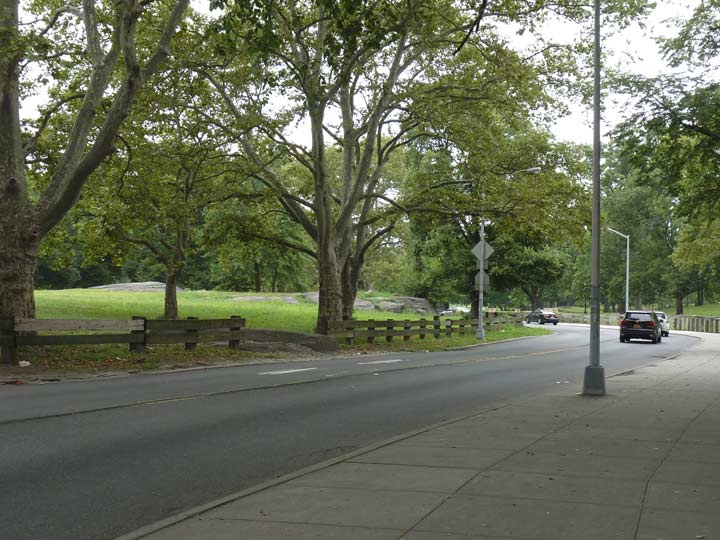
When I left off, I was making my way west on Claremont Parkway, which bisects the southern portion of Crotona Park and then runs west across a small neighborhood called Claremont Village to its namesake park at Webster Avenue.
Crotona Park and Claremont Park were formed out of the former preserves of the Bathgate and Zborowski de Montsaulain families, respectively. The Zborowskis had acquired their lands from the Morris family, which owned much of the southern Bronx in the 18th and 19th Centuries.
Claremont Parkway was originally a carriage road between the estates of the two families, which were friendly with each other. The name of the road has changed from Bathgate Place (1850) to Wendover Place (1890, commemorating local Congressman Peter Wendover, and finally in 1913 to Claremont Parkway.
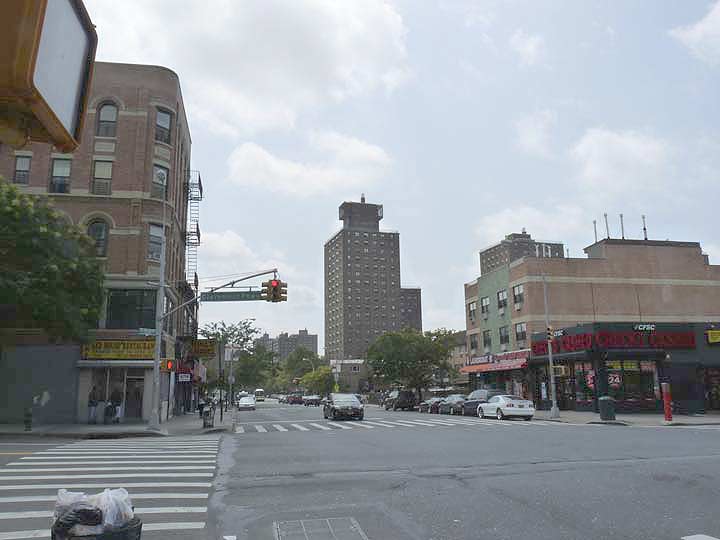
Looking south at Claremont Parkway and Third Avenue (which, in the Bronx, is usually spelled out on street signs and not numeralized (3rd) as it is in Manhattan. When the Third Avenue El was extended into the Bronx in the late 19th Century, western Bronx was still a part of New York County and the city decided to rename all the individually-named streets under the el and unite the road as Third Avenue.
The el clattered overhead, known in its later years as the #8 train, until 1973, when it was razed and replaced by bus service. The city has still never reassigned #8! When there was a skip stop #1 service in the 1990s, it was briefly known as the #9.
The tall tower in the background is part of the Gouverneur Morris Houses, named for a Founding Father.
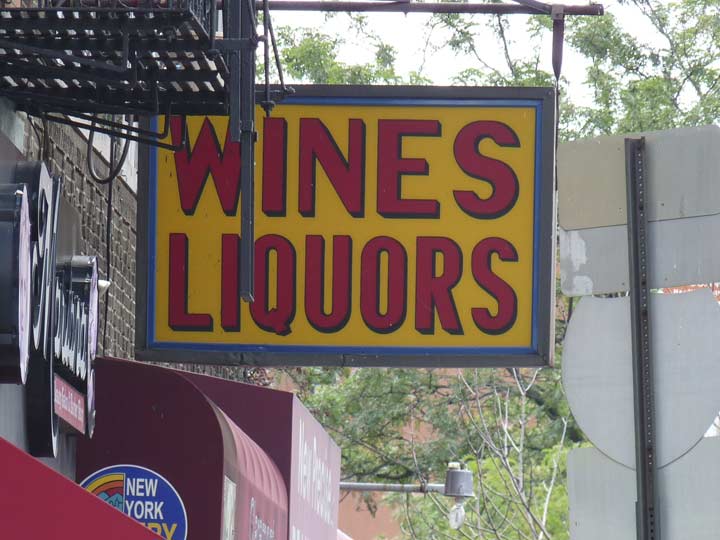
Colorful old school sidewalk sign advertising Claremont Liquors just south of the parkway on Third.

At first glance the Seven Light Baptist Church, on the southwest corner of Third and Claremont, seems like just another repurposed bank building of which there are many around town. That’s until you see the extraordinary bas reliefs on the pilasters on both facings, showing skyscrapers, early planes, the large passenger blimps called dirigibles (the Hindenburg, which crashed and burned in Lakehurst, NJ in 1937, was one) and locomotives. It’s possible that the bank, whichever it was, that occupied this building, was associated with transportation.
PS 42, Washington Avenue and Claremont Pkway. I was attracted by the wonderful serifed inscription above the front door.
Attracted to the weeping willow, I detored to Jardin de la Familia (“family garden”) at Washington and East 171st Street. The sign says the park will be finished in 2013; the finishing touches have yet to be applied.

The Morris Houses are on both sides of Washington Avenue south of East 171st, but this apartment house with the traditional Bronx curved edge is on the southwest corner. Contrast the detailing with the unadorned project skyscraper, seen in the above photo.
Now, here’s a mystery I hope someone can clean up for me. 432 Claremont Parkway, west of Park, is a 2-story brick building now home to a plumbing supplies wholesaler, but there are signs of its former use to be found near the roofline: carved heads in profile, accompanied by what look like dogs peeping out of portholes. Facing the Metro-North RR, there’s an elaborate iron structure with a helmeted figure (perhaps Mercury?) in the center.
Apparently this was the Claremont Casino or the Bronx Casino, built 1909. I didn’t shoot the front of the building — there’s some interesting bas reliefs. Check it out on Street View. (thx Marian Swerdlow)
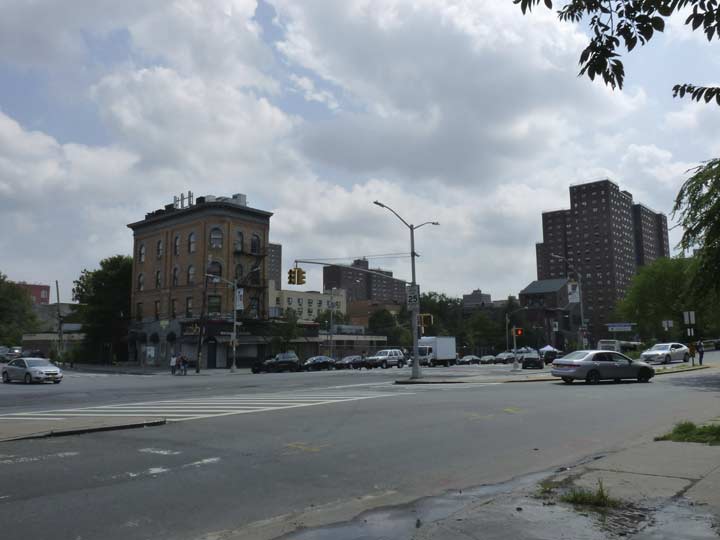
One of the more unusual street layouts occurs where Claremont Parkway begins at Webster Avenue and its namesake park. In this photo, the traffic in the rear is on Webster Avenue, while the road in the foreground is Clay Avenue. Because of the shape of Claremont Park (an arrowhead with the narrow end on the bottom) Clay Avenue bends northeast to touch Webster Avenue and then heads northwest along the east side of the park.
The origin of the name Clay Avenue is in dispute. It could honor Kentucky Whig senator Henry Clay, the “Great Compromiser” in the decades before the Civil War, or it could be named for the clayey ground engineers encountered when draining the Black Swamp from Claremont Park in the 1800s. (Webster Avenue is not named for Clay’s contemporary, New Hampshire/Massachusetts Whig US Representative and Senator Daniel Webster, but for either civil engineer Albert Webster or surveyor Joseph O. B. Webster.)
Claremont Park
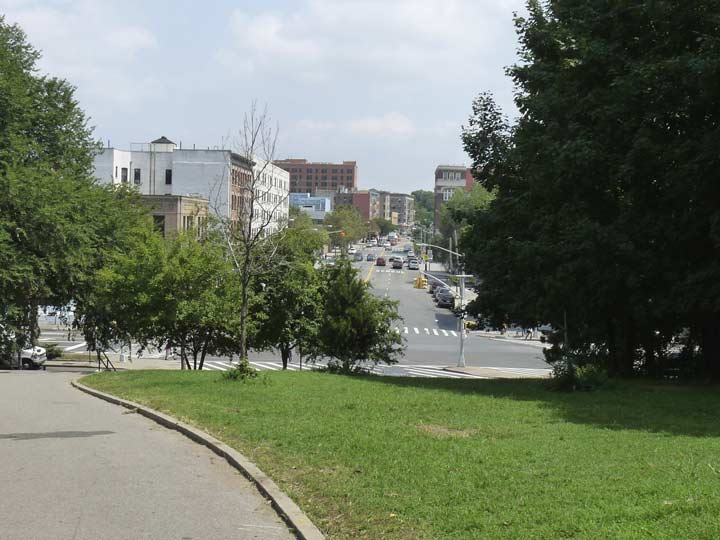
Claremont Parkway, seen from its namesake park
Elliott and Anna Zborowski de Montsaulain purchased the land that later became Claremont Park from the Morrises in 1858 and built a mansion Elliott named Claremont, or “clear mountain.” There is indeed hilly ground in the park — it’s one of three mid-Bronx hills: Claremont, the now-leveled Fairmount, and Mount Eden — that are referred to by the name Tremont, which became the Bronx’s longest route, stretching from the Harlem River to Long Island Sound.
In 1888 the City of New York purchased the property and set about creating a public space, draining the park’s Black Swamp, building park paths and constructing playgrounds over the next three decades. The Clermont mansion became the seat of the Bronx Parks Department until it was razed in 1938.
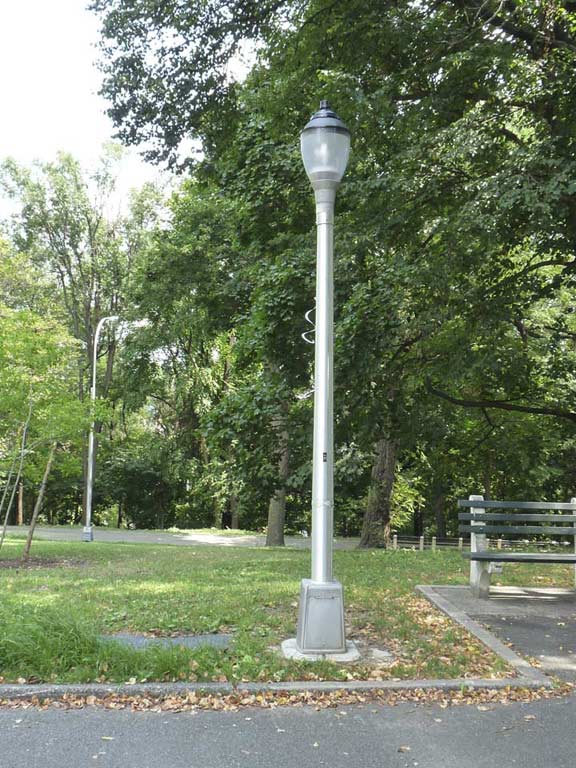
Here’s an unusual park lamp I came across in Claremont. It employs the squarish base and cylindrical shaft that are generally used to support stoplights and pedestrian control signs. I wonder if these hybrid types will be used more frequently in parks.
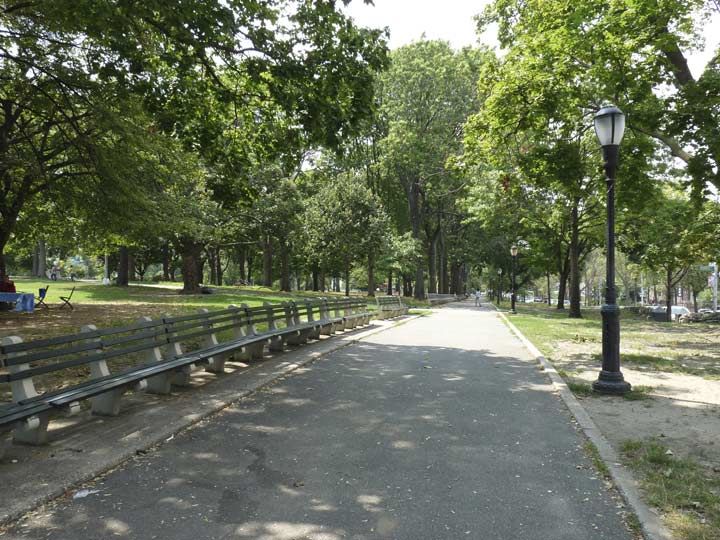
This pleasant promenade runs along the north side of the park and parallels Mount Eden Parkway.
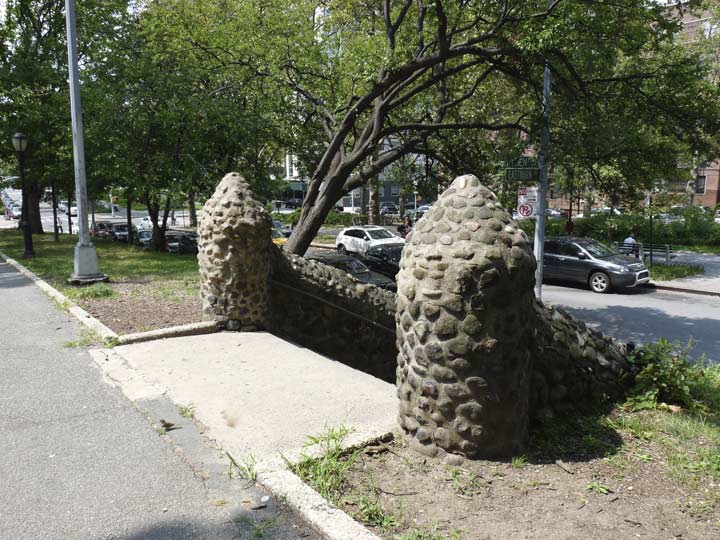
A pair of interesting “cobblestone” fenceposts on a staircase leading to Mount Eden Parkway. There are some more of these, along with some cobblestone walls, along Teller and Morris Avenues on the park’s west side.
Until 1926 the northern end of Claremont Park was bordered by a single lane street first called Walnut, for numerous walnut trees in the area, and then Jane Street. Then, the street, newly named Mount Eden Parkway was widened and center malls added between Walton and Weeks Avenue.
Malls, in the sense of grassy medians or lengthy green tracts, take their name from Pall Mall, a street in Westminster, London, England. Pall-mall, pronounced “pell-mell,” is a croquet-like game in which a ball is hit through an iron ring with a mallet. London’s Pall Mall, completed in 1661, was named for the game, which required a lengthy field. Malls have also come to mean large areas given over to stores and shopping.
Mount Eden itself, a hilly area included in Claremont Park, was named for landowner Rachel Eden who purchased the property in the early 1800s. Interestingly, she wasn’t the only Eden that found a place in property maps and street maps: the Edenwald estate founded by John H. Eden was located in Eastchester in the NE Bronx, and Edenwald Avenue runs through it.

The center malls of Mount Eden Parkway were named for Chet Henderson by the Parks department in 1987; Henderson
was active in improving the Grand Concourse Malls and other parts of the Bronx. He worked for the Departments of Sanitation, Water Resources and, as an Associate Public Relations Officer for the Department of Environmental Protection. Henderson also served as a board member on the Bronx Council for Environmental Quality. He founded and directed Operation Pride-Echo Park, and he started self-help programs for park-maintenance and worked with young community members. NYC Parks
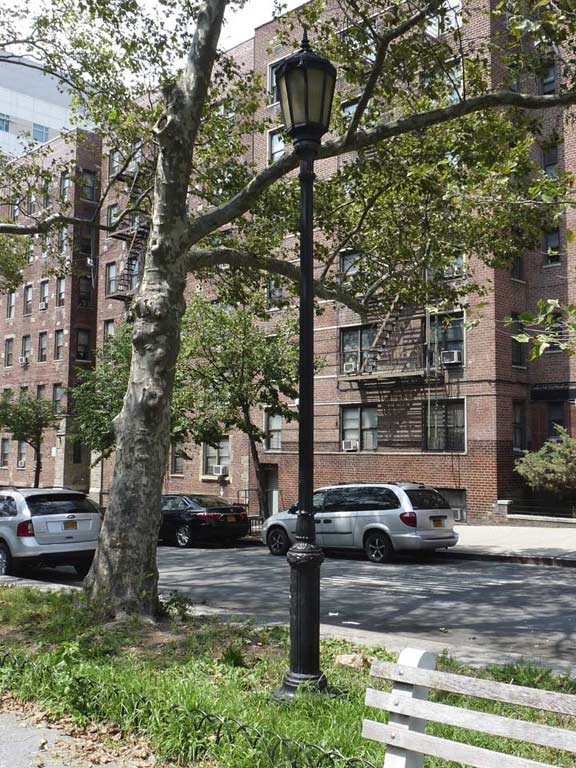
The Mount Eden malls have a unique (as far as I know) lamppost combination: a Type A post topped with an 8-paned glass post top, similar to the ones found on Riverside Drive at around West 158th.
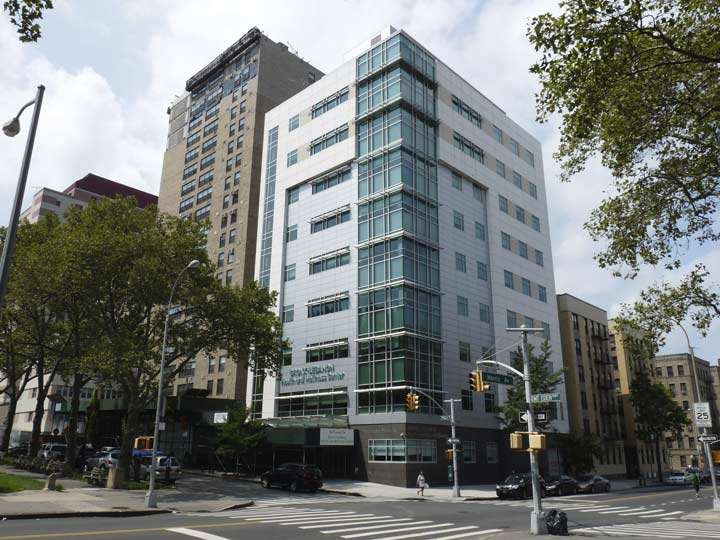
The new Bronx-Lebanon Health and Wellness Center, a building whose design I don’t mind, is on the NW corner of Mt. Eden Parkway and Morris Avenue. The building opened in 2014.
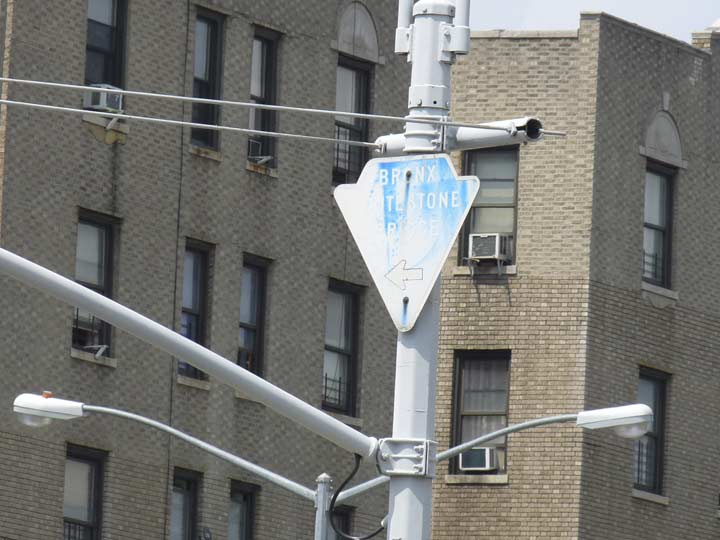
Here’s an increasingly rare “arrowhead” sign pointing to the Bronx-Whitestone Bridge directing traffic west on Mount Eden Avenue from the Concourse. This advice bears out, since to get to the Whitestone from here, you would make a right on Mt. Eden, another right on Jerome, and then another right at the Cross-Bronx Expressway, which foes to the BWB.
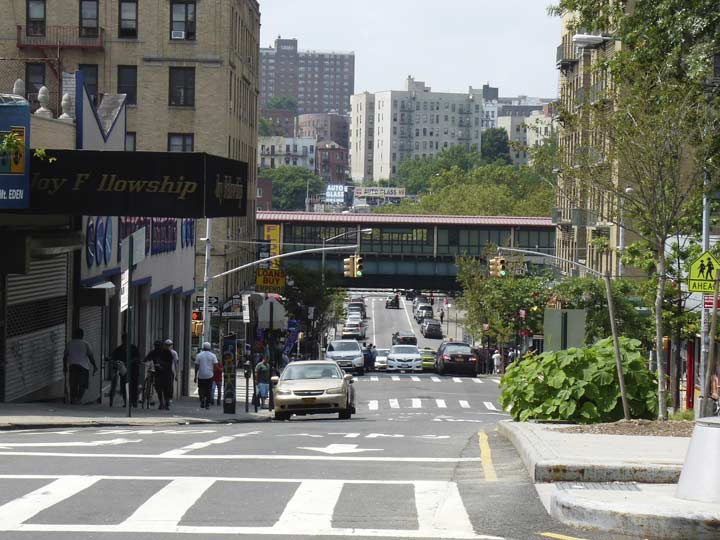
This is the west end of the Mount Eden Parkway mall at Walton Avenue. The Mt. Eden station on the #4 is a block ahead. The Sedgwick Houses loom on the horizon.
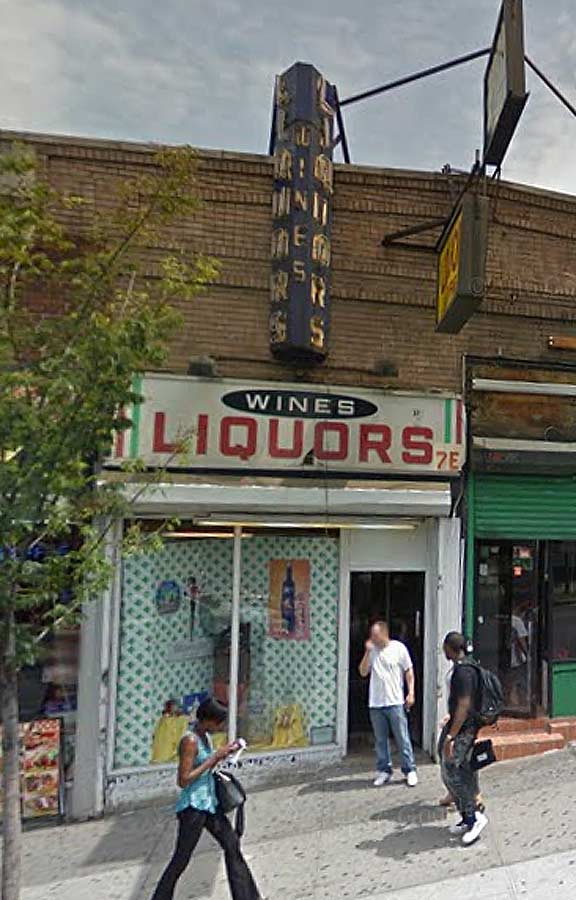
I didn’t follow Mt. Eden Avenue all the way to Jerome, but Street View shows a grand old liquor store neon and sidewalk sign combo.
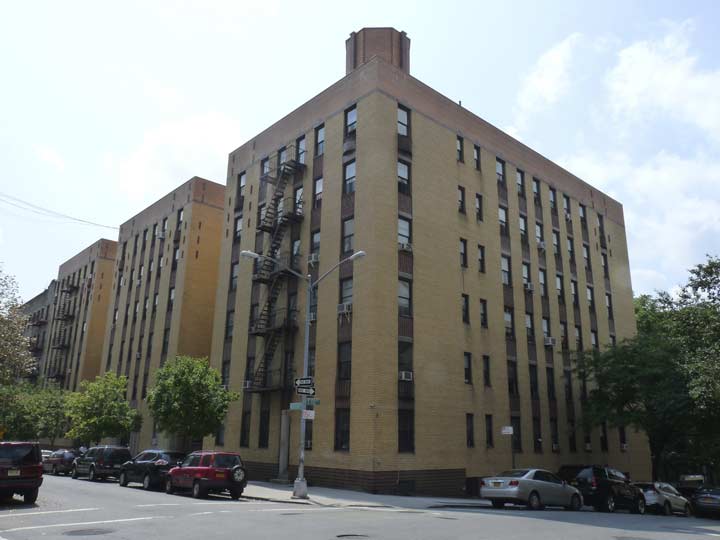
Some prime Art Deco apartment houses can be found on the Grand Concourse and its parallel routes like Walton Avenue, here at East 172nd Street.
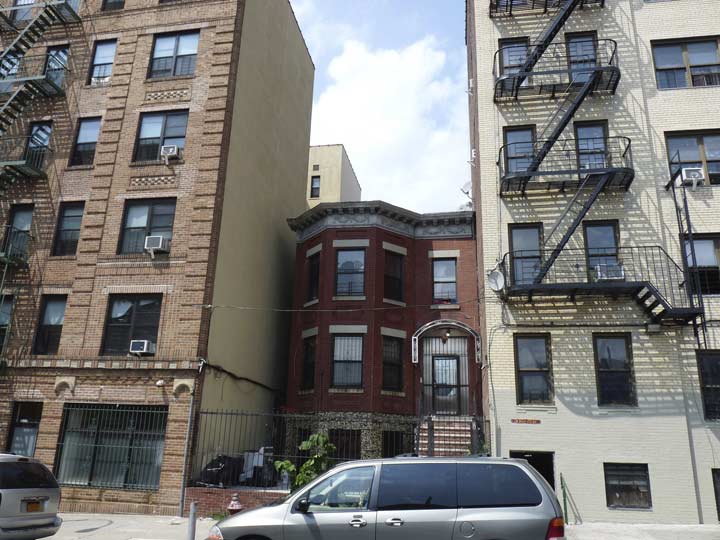
West 172nd, between Jerome and Inwood Avenues. This sort of thing happens often in the Bronx — a block of modest one or two story homes constructed in the early 20th Century converts to high rise apartment houses in mid-century — until maybe one or two of the originals are left, Davids in a block of Goliaths. Here’s another instance in Kingsbridge Heights.

The Bronx is the Borough of Apartment Houses. Here is a classic at the triangle made by Macombs Road and Cromwell Avenue.
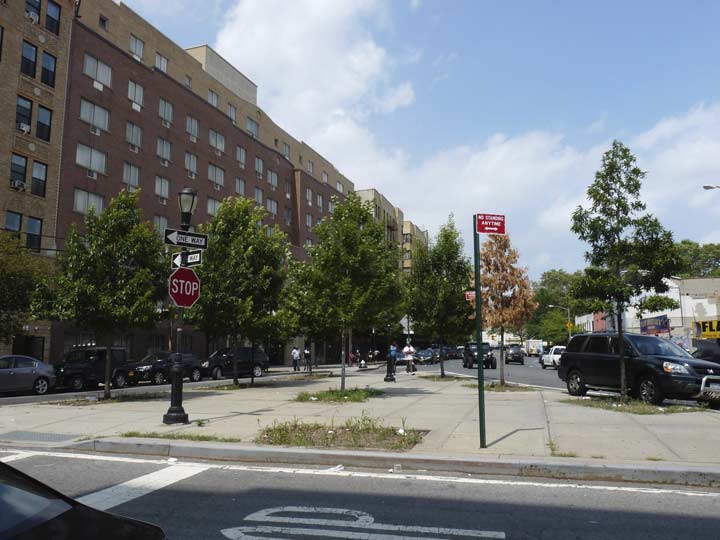
On the same triangle, here’s an unusual use for a Type A park lamp, holding Stop and One-Way signs.
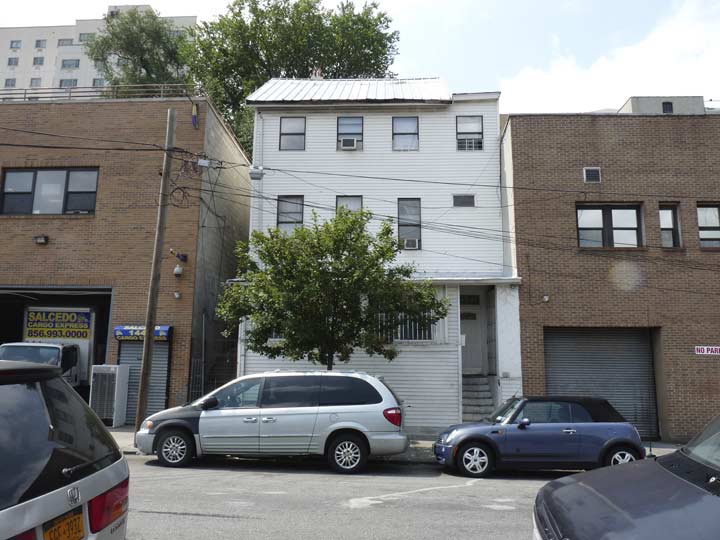
This small frame house on Cromwell Avenue north of West 170th is the lone such survivor on the block. I wonder what it looked like before all the siding. Its pitched roof can be seen clearly from the parking lot between Macombs Road and Cromwell.
I found an amazing block of houses on Shakespeare Avenue between West 168th and 170th. I wish I knew the story behind these homes. I do know the story behind Shakespeare Avenue, though.
The High Bridge neighborhood was in large part once the Marcher estate. The lord and lady of the property maintained a formal garden dedicated to the works of William Shakespeare and displayed busts of the Bard himself and some of his best-known characters. The heavy hand of modernity eventually encroached, and the property was sold off. Only Shakespeare Avenue is a current reminder of the Marcher estate and its garden.
I was attracted to these attached brick buildings on Plimpton Avenue between West 169th and 170th, especially the oriel window treatments and the carved ornamental entrances. Real craftsmanship. The avenue was named for George Plimpton, but not the George Plimpton of 20th Century literary fame, “amateur” professional sportsman, and the Paris Review, but rather the George Plimpton of 19th Century literary fame, a publisher of educational tracts and a treasurer of Barnard College.

West 170th snakes its way west to Martin Luther King Boulevard, which is liekly better known in these parts by its original name, University Avenue, named for the uptown New York University campus now occupied by Bronx Community College. Since mid-2015, this has been reactivated as the Bronx end of High Bridge, which has had its pedestrian access restored.
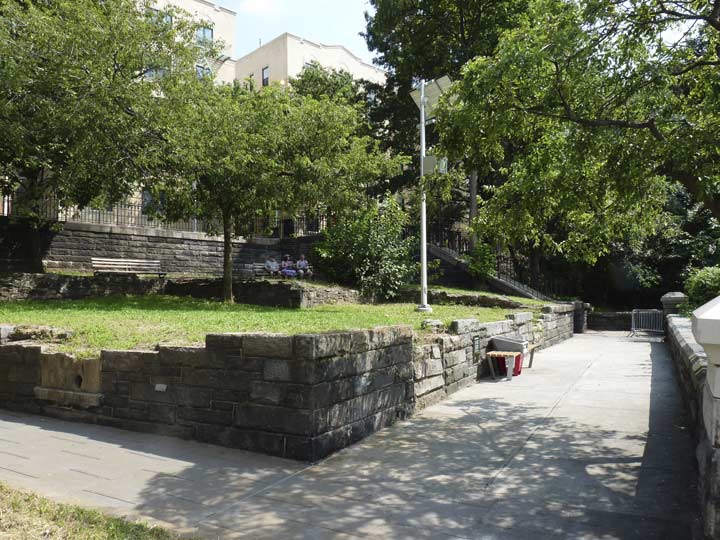
The small park on the Bronx side of High Bridge has always been open despite the bridge’s closure, but Parks has spiffed it up and added some new benches, such as…

… a bench by Soofa, a manufacturer of “street furniture” such as seats and phone kiosks. The claim to fame here is that it’s also a charging station for mobile phones and similar devices.
On one of the humidest dead dog days of August, I embarked on my second walk across High Bridge. I won’t have a lot to say here, if only because I said most of it during my initial 2015 walk when I talked about the bridge’s history.
One thing I didn’t mention is that the walkway paving definitely changes midway through the span. The reason for this is simple. While the original bridge was constructed on a series of stone arches between 1838 and 1848, half of the stone arches were replaced by a steel span in the 1920s because Harlem River boat traffic was coming too close to the masonry arches. Thus, the walkway also had to be removed and replaced. There’s no doubt in my mind that if this task was done in 2016, Parks would have meticulously matched the walkway brickwork style, but such details weren’t considered particularly important in 1925.
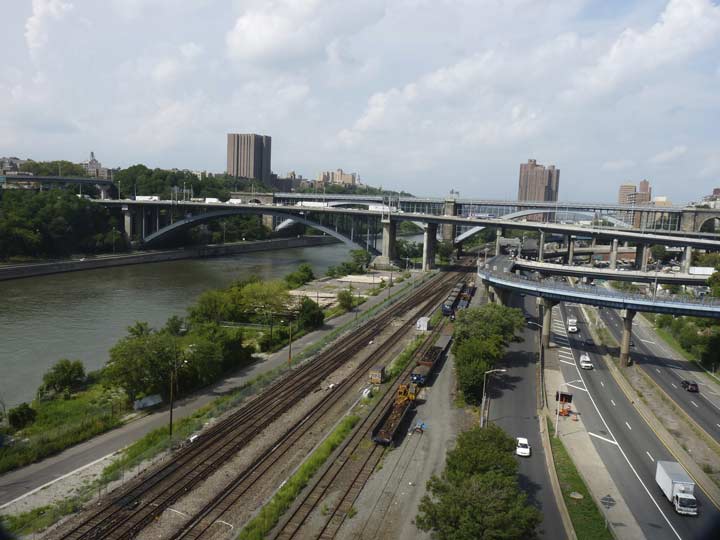
Looking north from High Bridge, we see the railyard along the Harlem River and the ramps connecting the Major Deegan Expressway to the Alexander Hamilton Bridge (foreground) and the Washington Bridge (not the George Washington Bridge) in the rear.
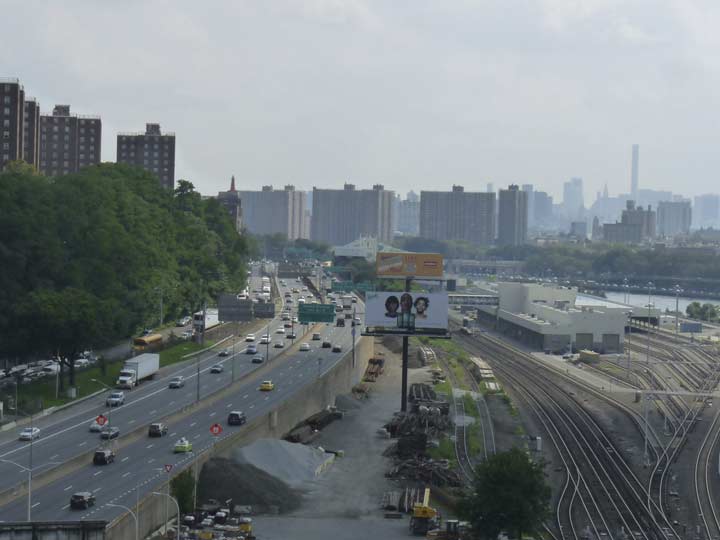
Looking south from High Bridge we see the housing project named for the bridge, as well as the Major Deegan again. The tallest residential building in the city, at least for 2016, 432 Park Avenue, is on the right. Look carefully and you will see the lighthouse statue that stands on the former H. W. Wilson Publishers on the left.
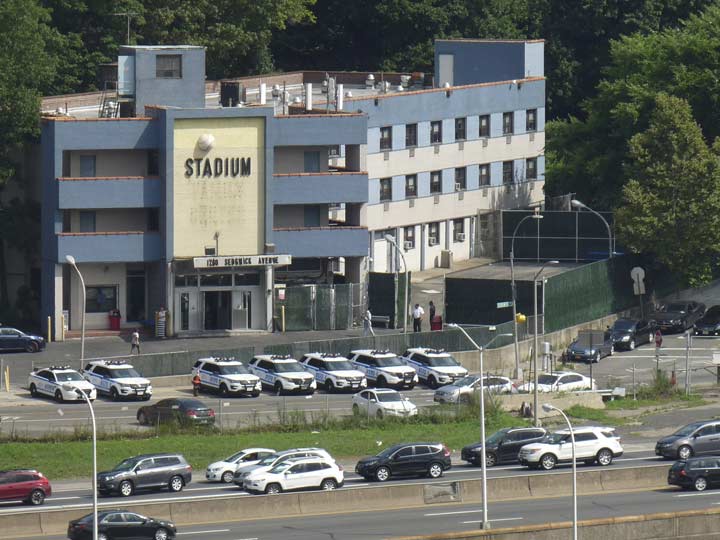
The former Stadium Family Center was constructed in 1959 on Sedgwick Avenue in the shadow of High Bridge; it has served as a women’s homeless shelter in recent years, and hence the “Family Center” has been removed from its facade.
You’ll get a great workout if you climb these steps every day that connect the upper level of High Bridge Park to the lower level that parallels the East River Drive. I count these as among the more difficult exterior staircases in town, the others being the Brush Staircase a little further south in High Bridge Park, the steps leading from Riverside Drive up to the Cloisters, and West 230th, NYC’s longest step street between Riverdale Avenue and Netherland Avenue in Spuyten Duyvil.
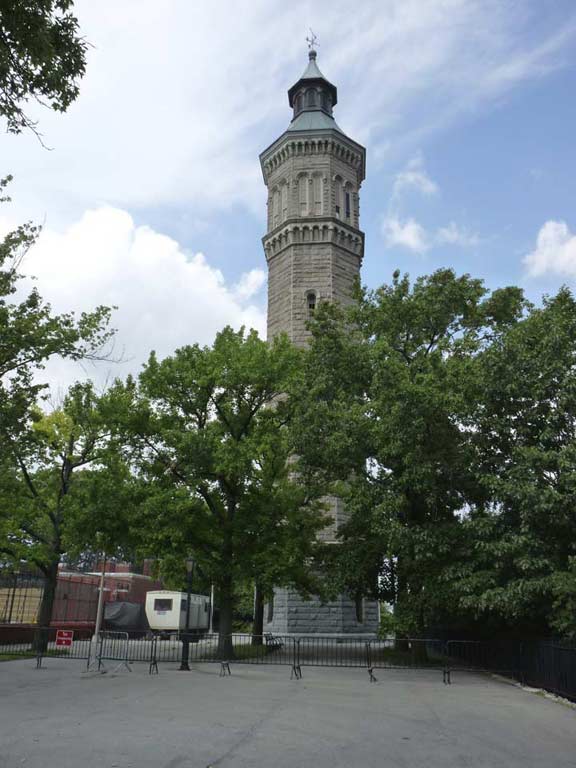
The High Bridge water tower was built by architect John Jervis a couple of decades after the bridge (1866-1872) and was used as a 47,000-gallon storage tank and as a water pressure equalizing structure. It has a winding spiral staircase inside whose climb, while a little winding if you’re not in terrific shape, rewards you with spectacular views of the surrounding Washington Heights, Harlem and Morrisania neighborhoods. The bridge was built as a conduit for water entering Manhattan from the upstate Croton Aqueduct.
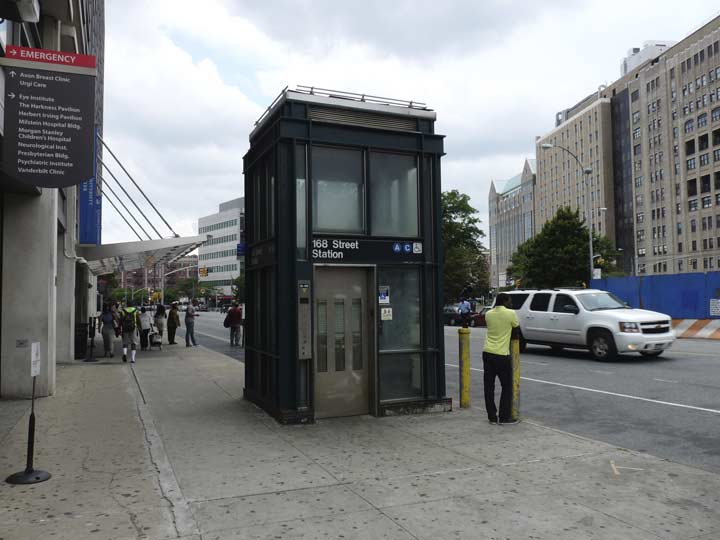
Time to kick it in the head for the day and enter the subway via the elevator at West 168th and St. Nicholas Avenue.
10/23/16


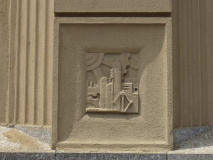
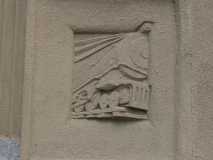

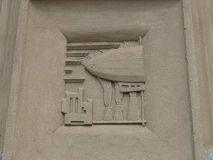
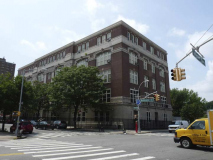
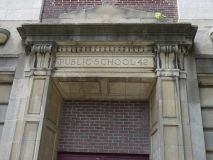
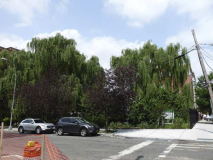
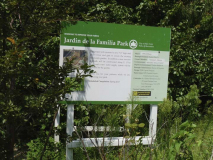
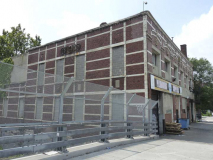

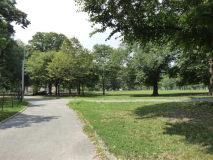
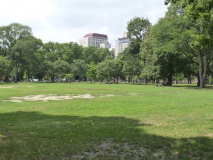
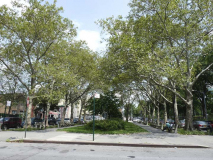
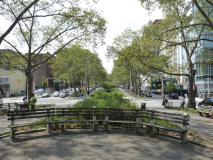
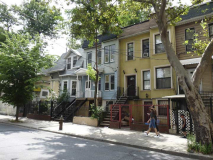

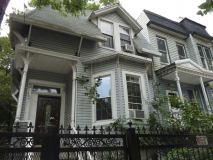
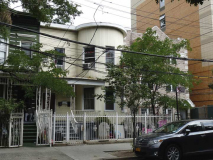
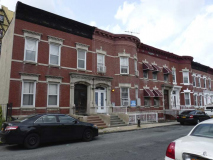
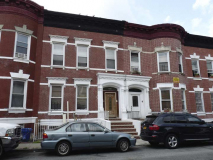
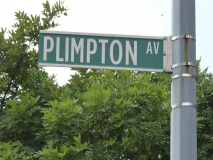

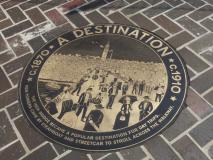
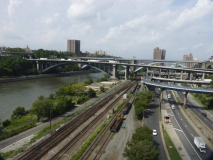
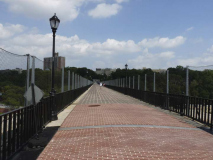
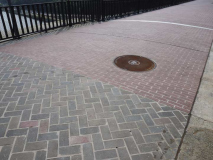
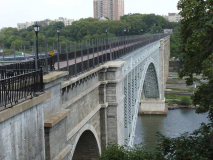
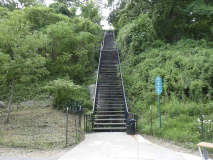
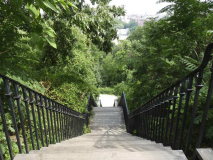
6 comments
corner of 451 claremont pkwy ny bronx and Washington ave across the st is ps42 just wntt o know if you know how i can get picsters of the building and how build it i was born i n the bronx we lived in
451 claremont pkwy ny bronx in 1957-1963 i am trying to get picture of this year for my scrape book of my life for my boys can you help or can you direct me or give me web
my parents past-a-way and i have nothing of my life our family was he aleman family
Winnie Cardona
cell 732 570 1545
can anyone help me
i lived on the corner of 451 claremont pkwy ny bronx and Washington ave across the st is ps42 just wnanted to know if you know how i can get picters of the building and how build it and was it taken down i was born i n the bronx we lived in
451 claremont pkwy ny bronx in 1957-1963 i am trying to get picture of theses year s for my scrape book of my life for my boys can you help or can you direct me or give me web
across the street is ps42 and once next to the building was a movie theater on Washington ave
my parents past-a-way and i have nothing of my life our family was he aleman family
Winnie Cardona
cell 732 570 1545
In 1957 I lived @ 1524 wash ave I went to PS 42 I moved out cause I was in show bizz and had to. This is a great sight , I also tried to get pictures of my building but couldn’t
Augie I lived in 1562 Washington Ave…I remember when you and you brothers moved… I think to Clay Ave. I remember Star Time and your song Oh where is Santa Claus. We were childhood friends and if I remember correctly your building was right next door to the shoemaker. I’ll see if you respond so we can chat
Ron
Valuable information. Fortunate me I discovered your site by chance, and I’m surprised why this coincidence didn’t came about earlier! I bookmarked it.
The Art Moderne building that houses the Seven Light Baptist Church at 3855 Third Avenue (NW corner Claremont Parkway) was designed by Eugene Schoen for the Public National Bank & Trust Company of New York (1930–31).